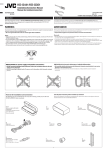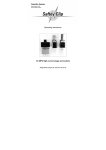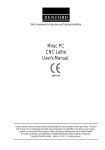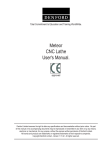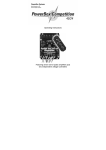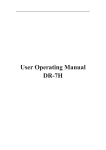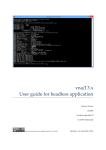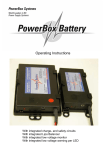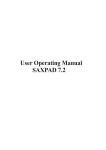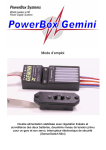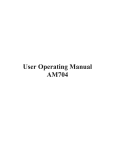Download Operating Instructions - Aircraft International
Transcript
Operating Instructions PowerBox Sensor Dear customer, we are delighted that you have decided to purchase the POWER BOX Sensor switch backer from our range. This is a modern, high-performance switch system with integral battery backer for your valuable model aircraft, containing two entirely independent electronic switches in addition to the dual battery coupling facility. We have also managed to combine these features with a linear stabilised power supply voltage for receiver and servos. The linear stabilised voltage is generated by two independent IC-controlled voltage regulators of extremely lowloss design. The switch backer is very simple and safe in operation (the same SensorSwitch system is used in our PowerBox “Competition” and “Champion”), but it is important that you understand its features if you are to make best use of it. Please read through these instructions so that you understand your new accessory fully. We wish you much pleasure and success with your POWER BOX Sensor. Inhaltsverzeichnis 1. 2. 3. 4. 5. 6. 1. Product description................................................................. Specification........................................................................... Connections and controls ....................................................... Operating and Safety Notes..................................................... Using the Sensor-Switch......................................................... Guarantee conditions.............................................................. Page Page Page Page Page Page 2 4 4 5 6 7 Product description The POWER BOX Sensor is the world’s first switch system for small to mediumsized models which combines the functions of a battery backer, dual de-coupled batteries, plus two independent electronic switches and two IC-controlled linear voltage regulators, each independent of the other. Naturally, each battery can be switched on and off separately. Our system also includes a SET button which provides an absolutely secure power-on / power-off method and protection against the effects of vibration. The PowerBox Sensor provides a linearly stabilised voltage of exactly 5.9 Volts for powering your receiver and servos. This fulfils exactly the requirements of all RC manufacturers who state a maximum permissible voltage of 6.0 Volts for their RC components. -2- PowerBox Sensor This ground-breaking overall design enables you to use the latest lightweight Lithium-Polymer cells as well as standard 5-cell NC and Hydride batteries, without exceeding the maximum voltage of 6.0 Volts. As you would expect, we can also supply these modern Lithium-Polymer batteries for your power supplies. We are the only manufacturer to rely exclusively upon the Li-Po cells made by IONITY AG in Germany; we do not use any cell types made in Asia. The POWERBOX Sensor is equipped with LED power-on indicators for both power circuits. If you switch one battery on, the associated green LED glows. When both batteries are active, both LEDs light up. The total voltage loss in the PowerBox Sensor (de-coupling diodes and voltage regulators) is about 0.35 V, which is so low that the volume of waste heat is almost negligible. The specified maximum continuous current is 5.0 Amps, which means that it easily cope with 6 - 8 standard servos or 5 - 7 digital servos. However, the rated continuous current of 5.0 A does not reflect the capacity of the electronics; it is a function of the size of heat-sink employed. The electronic circuit is able to handle twice the specified power without problem. The heat-sink is mounted on the rear of the unit, and it is important to ensure that the waste heat generated can be dissipated efficiently through this component. If you notice that the heat-sink becomes hot in use (above 60° Celsius), this is a reliable indication that the servos you are using are consuming a disproportionate amount of energy (power). Check your servos, linkages, pushrods etc. ! The unit features double battery and receiver cables, each with 0.34 mm² conductors. This means that voltage drop in the cables is very slight even at maximum load. The schematic circuit diagram below is intended to clarify the inter-related functions of the POWER BOX Sensor. It shows in graphic form how the individual components are linked together. -3- PowerBox Sensor 2. Specification Operating voltage: Power supply: 4.0 Volts to 9.0 Volts 2 x 5-cell NiCd or NiMH batteries, or 2 x 2-cell Lithium-Polymer batteries 5.0 Amps approx. 0.35 Volts (diode / regulator losses) 2 x 5.9 Volts (+/- 0.1 Volt) approx. 5µA -10°C to +75°C 35 g (complete incl. all cables) Max. load: Voltage loss: Voltage stabilisation: Idle current: Temperature range: Weight: 3. Connections and controls Connect the two batteries using the two UNI connectors. Both servo leads should be connected to the receiver. If all the receiver servo sockets are in use, use a Ylead for the second battery connection. The second battery lead increases operational security, as the current flowing is shared between the two cables and sets of pins. SET button, activates a switching process Red LED, indicates activation Switch button, battery 1 Switch button, battery 2 2 green LEDs, indicate switch status -4- PowerBox Sensor 4. Operating and Safety Notes Be sure to use top-quality batteries of low internal resistance to power your receiving system. Do not use receiver batteries of low capacity, as one pack may be required to provide full power to the system for the whole of a flight if the other battery should fail. Always use battery cells of the same type. We recommend that you use batteries with a capacity of at least 1700 mAh; for larger models we suggest packs of up to 3000 mAh capacity. You can use either Nickel-Cadmium batteries (NiCd), Nickel-Metal-Hydride batteries (NiMH) or Lithium-Polymer batteries. We strongly recommend our own range of high-quality batteries which are designed to be suitable for a wide range of applications in modelling. We particularly recommend our Lithium-Polymer battery packs with integral safety and charge electronics. These are based exclusively on the latest cells made by IONITY AG of Germany. In principle the POWER BOX Sensor can also be used with two separate receivers. However, please be sure to read the instructions provided by the radio manufacturer, as not all receivers work properly in tandem. In all cases the basic rule is to keep the two receivers away from each other - they should be spaced about 25 30 cm apart inside the model. The POWER BOX Sensor fulfils the requirements of the standard EMV directives, as reflected by the CE symbol on the unit. The CE symbol guarantees that the unit fulfils the statutory regulations relating to interference-free operation. This involves checking the unit’s radiation of interference and susceptibility to outside interference. The switch backer does not suffer interference from other electrical devices except under extremely severe conditions, and it does not radiate interference which could affect other devices (receiver, servos). The backer is designed exclusively for use in modelling applications and is only approved for use in radio-controlled models. The unit is designed for use with Direct Current power sources typified by 5-cell NC or NiMH batteries or two-cell Lithium-Polymer batteries. The unit must never be connected to a mains-powered PSU! -5- PowerBox Sensor 5. Using the Sensor-Switch The sensor buttons do not switch the current for the receiver and servos. The actual switching process is carried out by the two electronic switches in the POWER BOX Sensor, which are independent of each other. The controls on the front panel consist of three push-buttons, two green LEDs and one red LED. You will find two countersunk holes into which the mounting screws (supplied) fit. These are used to attach the switch to the model. The push-buttons are marked “SET” and “I” and “II”. The purpose of the slightly recessed “SET” button is to prepare and execute a switching process. Holding the “SET” button pressed in for about one second “arms” both internal switches, and the red LED lights up. You can now switch either or both power circuits on by pressing the other push-buttons “I” and “II”. This method of switching allows you to check each power circuit or battery separately. To switch off the POWER BOX Sensor, first hold the “SET” button pressed in, then press the push-buttons “I” and “II” in turn to switch both batteries off again. This new switching system as our own in-house development, and offers you the highest possible standard of security. When the electronic switches are in the “stand-by” state, i.e. the batteries are switched off, they draw an idle current of about 5 micro-Amps. This corresponds to a small fraction of the self-discharge rate of normal batteries. However, if you do not intend to use your model for a long period we recommend that you disconnect them from the POWER BOX Sensor, especially if you are using a Lithium-Polymer battery. The POWER BOX Sensor is virtually impervious to vibration, but it is still good practice to mount the unit in an area of the model where vibration levels are low. Please note that the GRP fuselage sides of a power model are not suitable, as they are always subject to considerable vibration. You can remedy the situation by cutting a ply plate (2 - 3 mm thick) about 3 cm larger than the switch aperture, and gluing it in the appropriate position. The plate damps the vibration, and at the same time provides plenty of “meat” into which the retaining screws of the POWER BOX Sensor can “bite”. -6- PowerBox Sensor 6. Guarantee conditions: During the production process each PowerBox Sensor undergoes a series of tests. We take the maintenance of the highest quality standards very seriously. We grant a 24 month guarantee on our products, valid from the initial date of purchase. The guarantee covers proven material faults, which will be corrected by us at no charge to you. We wish to emphasise expressly that we reserve the right to replace the unit if a repair is impossible for economic reasons. Repairs which our Service Department carries out for you do not extend the guarantee period. Misuse and maltreatment, such as reversed polarity, excessive voltage, the effects of damp and fuel invalidate the guarantee. The same applies to faults which are due to severe wear or excessive vibration. Additional claims, e.g. for consequent damages, are excluded. We do not accept liability for the device or the use of the device. If you have to return the unit to us, note that we cannot accept liability for transit damage or the loss of your shipment. If you need to make a claim under guarantee, send the unit to us at the following address, and be sure to include proof of purchase: Modellbau-Deutsch Hindenburgstraße 33 86609 Donauwörth Germany Liability exclusion: We are not in a position to ensure that this battery backer is operated correctly, nor that the entire radio control system has been maintained properly. For this reason we are unable to accept liability for loss, damages or costs which result from the use of the PowerBox Sensor, or are connected with its use in any way. Unless otherwise prescribed by binding law, our obligation to pay compensation, regardless of the legal argument employed, is limited to the invoice value of those of our products which were immediately and directly involved in the event which caused the damage. Donauwörth, April 2004 Yours - the Modellbau-Deutsch Team PowerBox Systems, Germany -7- PowerBox Sensor PowerBox Systems Modellbau-Deutsch Hindenburgstraße 33 86609 Donauwörth Tel: +49-0906-22559 Fax: +49-0906-22459 [email protected] www.PowerBox-Systems.com -8-








